Chapter-6 PMA Write-up
Introduction :
The goal of the labs for this chapter is to help you to understand the overall functionality of a program by analyzing code constructs. Each lab will guide you through discovering and analyzing a new code construct. Each lab builds on the previous one, thus creating a single, complicated piece of malware with four constructs. Once you’ve finished working through the labs, you should be able to more easily recognize these individual constructs when you encounter them in malware..
Lab 6-1 :
Q1 : What is the major code construct found in the only subroutine called by main?
Answer :
By looking to the graphic view we will see that there is comparison that decide which location to jump to, So typicallyit an IF-Statement that decides if the internet is connected or not.

Q2 : What is the subroutine located at 0x40105F?
Answer :
-
Before the function is called, we see some strings are pushed onto the stack, those strings are end with “\n” a “string buffer”.
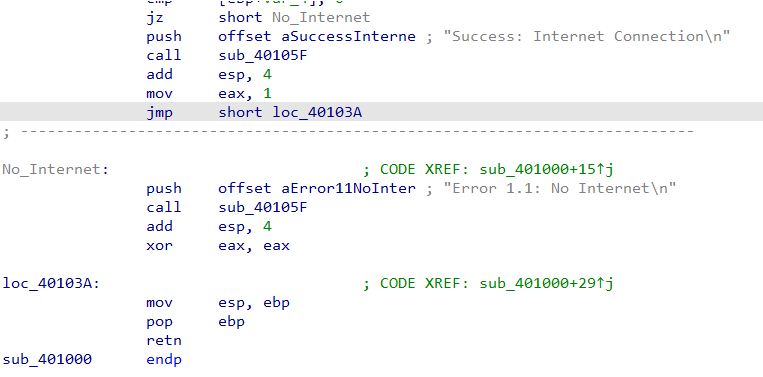
-
Next we see that “sub_40105F” is calling two function identified as “__stubf” and “__ftbuf”
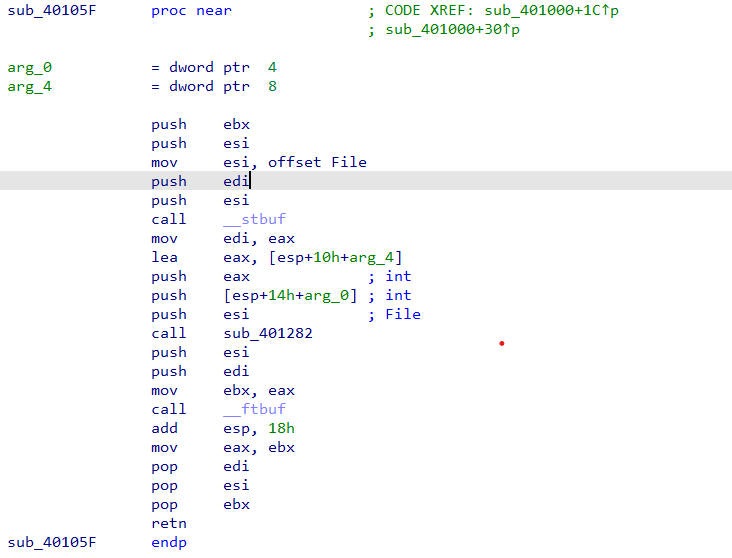
-
Typical to The .NET Core, internal.h “__stbuf” and “__ftbuf” are “string buffer” and “format buffer” in order which provides support for input/output of files.
-
Now we see that the “sub_40105F” is a “Printf” function that IDA wasn’t able to identify.
Q3 : What is the purpose of this program?
Answer :
Now we can tell that this function searchs for the status of the internet and prints it along with a return value (1) if connected (0) if not”.
Lab 6-2 :
Q1 : What operation does the first subroutine called by main perform?
Answer :
The first function is the same functions mentioned in “Lab 6-1” which was an IF-Statement that decides if the internet is connected or not.
Q2 : What is the subroutine located at 0x40117F?
Answer :
This function was also mentioned in “Lab 6-1” which was a “Printf” function that IDA wasn’t able to identify
Q3 : What does the second subroutine called by main do?
Answer :
-
Fisrt, we see “InternetOpenA” and “InternetOpenUrlA” functions which are used to open an “Internet Explorer” connection and navigate to the “http://www.practicalmalwareanalysis.com/cc.htm” HTML page.
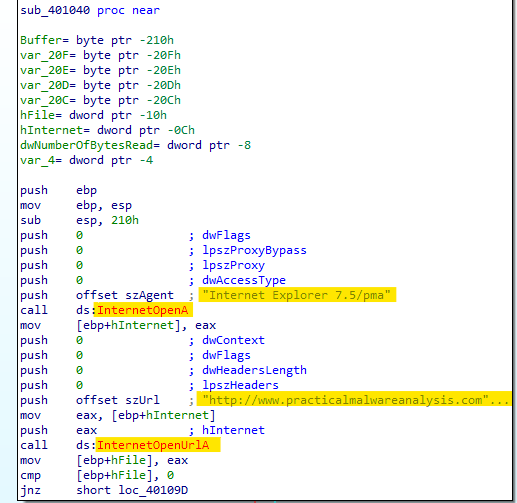
-
After that, a comparison occures to test if that connection happened. Then, we see a call to “InternetReadFile” that will be used to read a 200 Bytes from the HTML page.
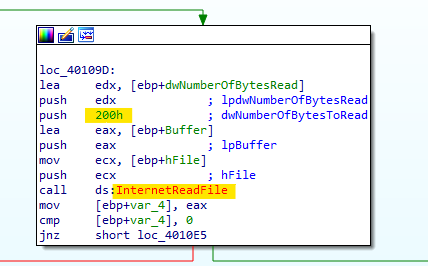
-
Again, a comparison occures to test if that command has been executed if so, it will test if a sequence of characters are equals to “3C”, “21”, “20” and “20” which in ASCII are “<!–” , this format is the comment format in HTML.
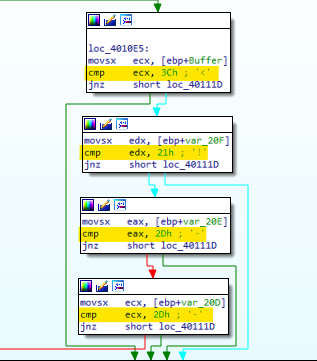
Q4 : What type of code construct is used in this subroutine?
Answer :
The main constructs in this code are “IF” statments to check the execution of commands and an “Array of characters” to store the bytes of the comment in the HTML page.
Q5 : Are there any network-based indicators for this program?
Answer :
There are two-network indicators:
- The program uses the HTTP User-Agent Internet Explorer 7.5/pma.
- The program downloads the web page located at: http://www.practicalmalwareanalysis.com/cc.htm.
Q6 : What is the purpose of this malware?
Answer :
The main purpose of the program is to search if the intrnet connection is set or not, If it is, it will open Internet Explorer and download an HTML-Web page and search for a certain character stored in the page as a comment and execute this command character and print “Success: Parsed command is @”, were @ is the command, If successful, the program will sleep for 1 minute and then terminate.
Lab 6-3 :
Q1 : Compare the calls in main to Lab 6-2’s main method. What is the new function called from main?
Answer :
The new called function is “sub_401130” which was in the “Lab06-02.exe”.
Q2 : What parameters does this new function take?
Answer :
There are 2 parameters being pushed onto the stack:
- The first is a long pointer to the argv ( arg[0] which is a reference to a string containing the current program’s name.)
- The second is a char which contain the value in EAX ( the returning value from “sub_401040”.)
 ___
___
Q3 : What major code construct does this function contain?
Answer :
IDA-PRO has already identified the main construct as a Switch case statment with a jump table technic.

Q4 : What can this function do?
Answer :
The switch statment can do 6 options depende on the case, The options are :
- Create the path “ C:\Temp” if it doesn’t already exist.
- Copy the file “Lab06-03.exe” to “C:\Temp\cc.exe.”
- Delete the file “C:\Temp\cc.exe” if it exists.
- Set a value in the Windows registry found in “Software\Microsoft\Windows\CurrentVersion\Run" under the name of “Malware” to make the “C:\Temp\cc.exe.” start at system boot, (gainig persistence)
- Sleep for 100 seconds.
- Print “Error 3.2: Not a valid command provided.”

Q5 : Are there any host-based indicators for this malware?
Answer :
Coping the program to “C:\Temp\cc.ex” and seting it as a “start at system boot” process are considerable host-based indicators.
Q6 : What is the purpose of this malware?
Answer :
The main purpose of the program is to search if the intrnet connection is set or not, If it is, it will open Internet Explorer and download an HTML-Web page and search for a certain character stored in the page as a comment, The character will be tested in Switch statment to determine what action will be taken, All options are a guarantee that the program will start at system boot, Finally it prints “Success: Parsed command is @”, were @ is the command, If it all done, the program will sleep for 1 minute and then terminate.
Lab 6-4 :
Q1 : What is the difference between the calls made from the main method in Labs 6-3 and 6-4?
Answer :
We can see that there is nothing changed in the functions called by the main method.
Q2 : What new code construct has been added to main?
Answer :
We see a Loop-Statement has been added, “var_c” is the counter for this loop which was intialized to 0 and incremented by 1 every cycle untill it reatches 1440 “24 hours”, it will break.

Q3 : What is the difference between this lab’s parse HTML function and those of the previous labs?
Answer :
- The new “sub_401040” now takes argument which is the counter of the loop.
- A new variable “szAgent” has been created and populated with the formatted User-Agent “Internet Explorer 7.50/pma%d.”
- After that, we see “Sprintf” is being called, which creates the string and stores it in the destination buffer.
- This means that every time the counter increases, the User-Agent will change.

Q4 : How long will this program run? (Assume that it is connected to the Internet.)
Answer :
Assuming that the Internet is connected, the loop will be taken the 1440 cycle and sleep 60000 milisecond (1-minute) after each cylce, So this program will terminate after 1440 minute (Typically 24 hours).
Q5 : Are there any new network-based indicators for this malware?
Answer :
There are two-network indicators:
- The program uses the HTTP User-Agent Internet Explorer 7.5/pma%d, , where %d is the number of minutes the program has been running.
- The program downloads the web page located at: http://www.practicalmalwareanalysis.com/cc.htm.
Q6 : What is the purpose of this malware
Answer :
By opining the script in VScode we see The main purpose of the program is to search if the intrnet connection is set or not, If it is, it will open Internet Explorer and download an HTML-Web page and search for a certain character stored in the page as a comment, The character will be tested in Switch statment to determine what action will be taken, All options are a guarantee that the program will start at system boot, Finally it prints “Success: Parsed command is @”, were @ is the command, If it all done, the program will sleep for 1 minute, then repeat, After a full 24-hours of repreating the program will terminate.
THE END